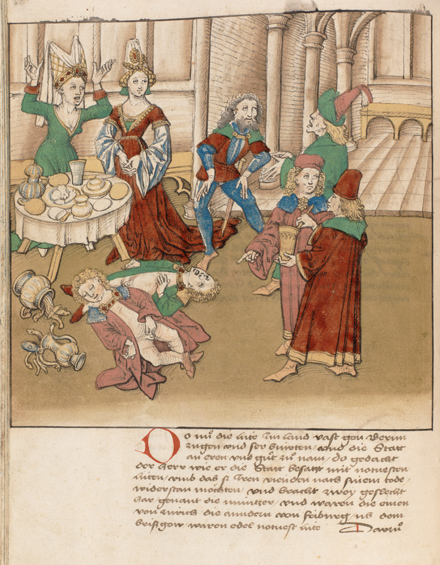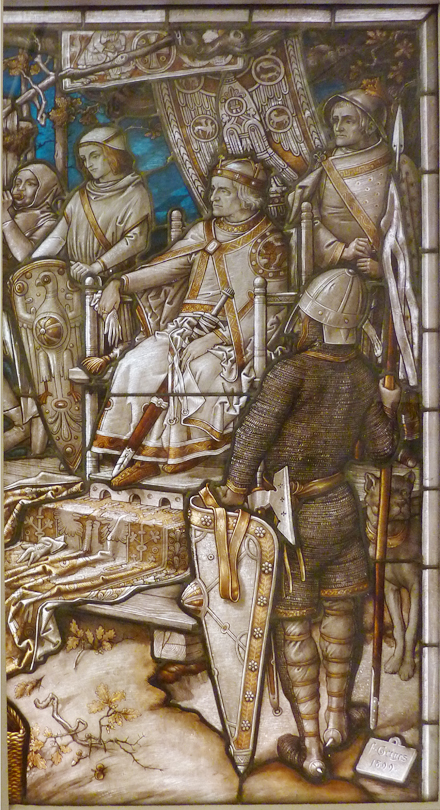Castles and Feuds
Freiburg, Dec 14, 2018
Who knew that Freiburg is the most ancient city north of the Alps to have been founded by a temporal prince? For it was Conrad I, Duke of Zähringen, who, almost 900 years ago, granted the small settlement that nestled at the foot of what was then Zähringen Castle mount (now the Schlossberg) the right to hold a market – leading to the economic growth of the town and its development into a city. The 800th anniversary of the death of the last Duke of Zähringen, Berthold V in 1218, is the occasion for the exhibition “The House of Zähringen. Myth and Reality”, which can now be seen in the Meckelhalle at the Sparkasse Finance Center in Freiburg. From March 2019 the exhibition, which was developed with the assistance of historians from the University of Freiburg, will be going on tour to all the eleven other Zähringen cities. Hans-Dieter Fronz took a look and gives an introduction.

A reconstruction of Zähringen Castle on Freiburg’s mount Schlossberg. Illustration: Hans-Jürgen van Akkeren
Noble family with a pedigree
The genealogy of the noble family of the dukes of Zähringen and counts of Freiburg has an impressive pedigree, and members of the family were amongst the most influential princes in the realm in the 11th to 13th centuries. As count and duke, Berthold I, who founded the House of Zähringen, held far-flung estates in Swabia and Ortenau, Breisgau and Thurgau. A supporter of King Henry III, he rose as Duke of Carinthia and Margrave of Verona to the aristocracy. In 1092 his son Berthold II was elected Duke of Swabia against Frederick I of Hohenstaufen by an opposing group of princes in the conflicts that were known as the Investiture Controversy. Berthold II then moved his center of power to the Breisgau, making his home at Zähringen Castle near Freiburg; around 1100 he was called “Berthold of the House of Zähringen” after this castle for the first time. His successor Berthold III died a violent death during a feud in 1122. The Bertoldstraße and Bertoldsbrunnen in Freiburg are named after him, however the foundation of the City of Freiburg in 1120 was actually the work of his younger brother and successor: Conrad I acquired possessions in what is now north-western Switzerland and was awarded the honor of “Rector of Burgundy” by the king, an honor that he passed to his successor. The last Duke of Zähringen, Berthold V, was proposed by a minority as a candidate for the king’s throne against Philip of Swabia, Duke of Hohenstaufen, during the election of the king in Cologne in 1198. In renouncing his claim, he consolidated the possessions of the House of Zähringen.

Related by blood or by marriage, with many branches: the magnificent family tree shows the genealogy of the House of Zähringen. Photo: Städtische Museen Freiburg. Augustinermuseum, Inv. no. 00160. M. Jensch
Castles, abbeys, cities
As befits their time, the dukes of Zähringen were warlords and conducted feuds in pursuit of their interests. However they also founded abbeys and cities, built churches and mighty fortresses. “The Castle of Burgdorf in Switzerland was a sizable secondary seat of power, with a fortified tower, a mighty keep and a grand hall. Situated on the left bank of the Rhine, as a ducal residence Burgdorf was a counterpart to Freiburg on the opposite bank,” says Dr. Heinz Krieg of the University of Freiburg’s Department of History, one of the exhibition’s four curators. By founding settlements and abbeys in the Black Forest, the dukes of Zähringen expanded their influence. Reformed abbeys amongst Zähringen bailiwicks, such as St. Peter, which became the burial place of the House of Zähringen, and St. Blasien, also served to reclaim large areas of the Black Forest. “Freiburg is the first city in the realm north of the Alps to have been founded by a temporal prince,” says Krieg. Numerous other cities like Freiburg were founded in Üechtland, Bern, Rheinfelden, Thun, Burgdorf and Villingen. They encouraged a large growth in market activity, which was an essential part of the foundation of cities at that time, over wider areas.

Dead under the table: a manuscript depicts the poisoning of two sons of Berthold. Photo: Bern, Burgerbibliothek, Mss.h.h.I. 16, p. 62. Diebold Schilling, Spiezer Chronik
Agnes and Clementia provided royal blood
The political and dynastic interests of the House of Zähringen were reflected in its marriage strategy. Agnes, wife of Berthold II, as the daughter of Duke Rudolf of Rheinfelden, brought royal blood into the pedigree of the House of Zähringen. Then, with Clementia, the wife of Conrad I and daughter of Count Gottfried of Luxembourg-Namur, opportunities arose for the House of Zähringen to expand its domain into Niederlothringen. Conrad I also had his daughter christened Clementia. When she married Duke Henry the Lion in 1147, an alliance of Zähringen and Welf arose. However, the marriage was annulled in 1162 apparently on account of too close a familial relationship. In fact, the claims of the House of Zähringen in the Upper Rhine region and Burgundy were getting in the way of the ambitions of Holy Roman Emperor Frederick (Barbarossa), who brought about the annulment.

Economic upswing: Duke Conrad of Zähringen granted Freiburg the right to hold markets in 1120. Photo: Wikimedia Commons
The last of the House of Zähringen
As the duke of Zähringen, Berthold V bore the imperial eagle on his coat of arms. Born in 1160, he founded the city of Bern at the age of 31. He is also famed for the mighty fortresses he had built. The prestige of the House of Zähringen was at its zenith during his reign. In 1198 Berthold withdrew his candidacy for the throne against Philip of Swabia in return for compensation. However he also had his enemies and others who envied him, and this gave rise to many legends about him. For instance, Berthold made an enemy of the Cistercian abbey of Tennenbach. As punishment for this, the Cistercian monk Caesarius of Heisterbach wrote of him in a letter as an “inhuman tyrant” and “denier of the Catholic faith” and after his death claimed the devil exultantly prepared a “great fire” for his “dear friend” in Mount Etna. By contrast, in Bern there was the legend of the poisoning of two sons of Berthold. (Note to self: found cities and never annoy Cistercian monks, to protect your reputation and ensure it flourishes.) Officially, Berthold V was without male heirs, and as a result, the line of the House of Zähringen died out on his death in 1218.
Myth and Reality
The exhibition “The House of Zähringen. Myth and Reality” has been curated by the University of Freiburg’s Department of History, the Freiburg city archive, the Alemannische Institut Freiburg and the Sparkasse Nördlicher-Breisgau. The exhibition is open until 1st February 2019 in the Meckelhalle at the Sparkasse Finance Center, Kaiser-Joseph-Str. 186, Monday to Friday, 9 a.m. to 6 p.m. Admission is free.
More information

